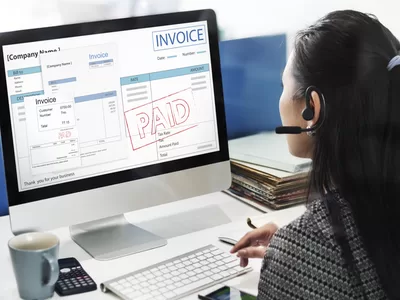Managing accounts payable and receivable in a medical office’s complex financial ecosystem is a critical responsibility that can have a substantial impact on its overall operations and financial health. Accounts payable and receivable are two critical components of the revenue cycle, and their effective management is critical to the smooth operation of a medical practice. In this post, we will look at how these components affect a medical office, the issues they provide, and successful management solutions.
Accounts payable (AP) is the amount of money owed by a medical office to its suppliers, vendors, and creditors. Medical supplies, medications, equipment upkeep, rent, and utilities are all examples of these costs. Effective AP management is critical for various reasons:
Accounts Payable and Receivable: Key Factors Impacting a Medical Office
In the intricate financial ecosystem of a medical office, managing accounts payable and receivable is a crucial task that can significantly affect its overall operations and financial health. Accounts payable and receivable are two fundamental components of the revenue cycle, and their efficient management plays a pivotal role in ensuring the smooth functioning of a medical practice. In this article, we will delve into how these elements influence a medical office, the challenges they present, and strategies for effective management.
Accounts Payable in a Medical Office:
Accounts payable (AP) refers to the money a medical office owes to its suppliers, vendors, and creditors. These expenses encompass a wide range of costs, such as medical supplies, pharmaceuticals, equipment maintenance, rent, and utilities. Effectively managing AP is essential for several reasons:
Cash Flow Management:
Efficient AP management allows a medical office to maintain a healthy cash flow. By paying bills on time and optimizing payment terms, a practice can avoid late fees and penalties while preserving capital for other critical needs.
Supplier Relationships:
Building and maintaining positive relationships with suppliers is essential for securing favorable terms, discounts, and priority service. Timely payments strengthen these relationships and can lead to cost savings over time.
Regulatory Compliance:
In the healthcare industry, compliance with regulations is paramount. Delays or inaccuracies in AP processing can lead to compliance issues, potentially resulting in fines or legal repercussions.
Budget Planning:
Accurate tracking of AP enables a medical office to create realistic budgets, allocate resources efficiently, and plan for future expenses effectively.
The intricacy of healthcare billing and coding, the need for precise record-keeping, and remaining up to date with new rules are all challenges in managing accounts payable in a medical practice. Implementing an electronic AP system can help to reduce these difficulties by streamlining operations, improving accuracy, and increasing transparency.
Accounts Receivable in a Medical Office:
Accounts receivable (AR) represents the funds that a medical office expects to receive from patients, insurance companies, and other payers for services rendered. Managing AR is equally critical, as it directly impacts the practice’s revenue and financial stability:
- Revenue Optimization: Timely and accurate billing and claims processing are essential for maximizing revenue. Any delay or error in these processes can result in revenue leakage.
- Patient Satisfaction: The billing and collection process can significantly influence patient satisfaction. Clear and transparent communication about financial responsibilities and efficient claims processing can enhance the patient experience.
- Aging AR: An aging accounts receivable can be detrimental to a medical office. It represents unpaid claims that become harder to collect over time. Effective AR management involves identifying and addressing aging AR promptly.
- Cash Flow and Financial Planning: Managing AR contributes to stable cash flow, allowing a medical office to cover its operational expenses, invest in growth, and plan for the future
Challenges in managing accounts receivable in a medical office include the complexities of medical billing and coding, dealing with denials and claim rejections, and navigating the intricacies of insurance reimbursement. To address these challenges, medical offices often invest in revenue cycle management software and employ dedicated billing and coding specialists.
Interplay Between AP and AR:
The interaction of accounts payable and receivable is a delicate balance. An efficient AP process guarantees that the medical office meets its financial commitments, whilst an optimized AR process ensures that payments are received on time. When these systems are in sync, the practice is able to maintain financial stability and growth.
For example, inefficient AP management might result in delayed payments to suppliers and creditors, harming the practice’s reputation and potentially resulting in service delays. However, if AR is not well managed, it might lead to delayed revenue, affecting the practice’s capacity to cover expenses and invest in its future.
Strategies for Effective Management:
- Implement Automation:Leveraging technology and automation can streamline both AP and AR processes. Electronic billing systems, payment portals, and accounting software can reduce errors, improve efficiency, and enhance accuracy.
- Regular Reconciliation:Consistently reconcile financial statements to ensure that accounts payable and accounts receivable are accurate and up-to-date
- Clear Communication: Maintain open communication channels with suppliers, creditors, patients, and insurance companies. Clear communication can lead to faster dispute resolution and smoother transactions.
- Training and Education: Invest in ongoing training for staff responsible for AP and AR management to keep them updated on industry changes, regulations, and best practices.
- Outsourcing: Consider outsourcing some aspects of AP and AR management to specialized firms, especially if the practice lacks in-house expertise or resources.
- Monitor Key Performance Indicators (KPIs): Regularly track KPIs such as accounts receivable turnover ratio, days in accounts receivable, and accounts payable turnover ratio to gauge the financial health of the practice.
Finally, accounts payable and receivable are critical components of the financial operations of a medical clinic. Maintaining cash flow, ensuring regulatory compliance, and supporting the practice’s overall financial health all require effective administration of these responsibilities. Medical offices may successfully manage the difficulties of AP and AR by adopting efficient processes, employing technology, and staying updated about industry developments. This benefits both the business and its patients.





